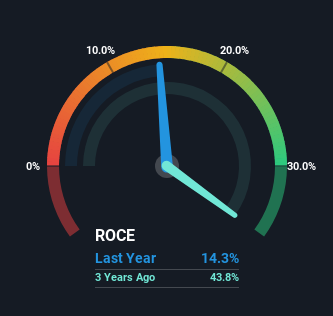- United States
- /
- Specialty Stores
- /
- NasdaqGS:ARHS
Arhaus (NASDAQ:ARHS) May Have Issues Allocating Its Capital

Did you know there are some financial metrics that can provide clues of a potential multi-bagger? In a perfect world, we'd like to see a company investing more capital into its business and ideally the returns earned from that capital are also increasing. Ultimately, this demonstrates that it's a business that is reinvesting profits at increasing rates of return. In light of that, when we looked at Arhaus (NASDAQ:ARHS) and its ROCE trend, we weren't exactly thrilled.
What Is Return On Capital Employed (ROCE)?
If you haven't worked with ROCE before, it measures the 'return' (pre-tax profit) a company generates from capital employed in its business. Analysts use this formula to calculate it for Arhaus:
Return on Capital Employed = Earnings Before Interest and Tax (EBIT) ÷ (Total Assets - Current Liabilities)
0.14 = US$112m ÷ (US$1.2b - US$392m) (Based on the trailing twelve months to June 2024).
Therefore, Arhaus has an ROCE of 14%. That's a relatively normal return on capital, and it's around the 12% generated by the Specialty Retail industry.
Check out our latest analysis for Arhaus

Above you can see how the current ROCE for Arhaus compares to its prior returns on capital, but there's only so much you can tell from the past. If you're interested, you can view the analysts predictions in our free analyst report for Arhaus .
So How Is Arhaus' ROCE Trending?
The trend of ROCE doesn't look fantastic because it's fallen from 24% four years ago, while the business's capital employed increased by 526%. That being said, Arhaus raised some capital prior to their latest results being released, so that could partly explain the increase in capital employed. The funds raised likely haven't been put to work yet so it's worth watching what happens in the future with Arhaus' earnings and if they change as a result from the capital raise.
On a related note, Arhaus has decreased its current liabilities to 33% of total assets. So we could link some of this to the decrease in ROCE. What's more, this can reduce some aspects of risk to the business because now the company's suppliers or short-term creditors are funding less of its operations. Since the business is basically funding more of its operations with it's own money, you could argue this has made the business less efficient at generating ROCE.
In Conclusion...
In summary, Arhaus is reinvesting funds back into the business for growth but unfortunately it looks like sales haven't increased much just yet. Although the market must be expecting these trends to improve because the stock has gained 43% over the last year. But if the trajectory of these underlying trends continue, we think the likelihood of it being a multi-bagger from here isn't high.
One more thing to note, we've identified 1 warning sign with Arhaus and understanding it should be part of your investment process.
While Arhaus may not currently earn the highest returns, we've compiled a list of companies that currently earn more than 25% return on equity. Check out this free list here.
New: Manage All Your Stock Portfolios in One Place
We've created the ultimate portfolio companion for stock investors, and it's free.
• Connect an unlimited number of Portfolios and see your total in one currency
• Be alerted to new Warning Signs or Risks via email or mobile
• Track the Fair Value of your stocks
Have feedback on this article? Concerned about the content? Get in touch with us directly. Alternatively, email editorial-team (at) simplywallst.com.
This article by Simply Wall St is general in nature. We provide commentary based on historical data and analyst forecasts only using an unbiased methodology and our articles are not intended to be financial advice. It does not constitute a recommendation to buy or sell any stock, and does not take account of your objectives, or your financial situation. We aim to bring you long-term focused analysis driven by fundamental data. Note that our analysis may not factor in the latest price-sensitive company announcements or qualitative material. Simply Wall St has no position in any stocks mentioned.
About NasdaqGS:ARHS
Arhaus
Operates as a lifestyle brand and premium retailer in the home furnishings market in the United States.
Flawless balance sheet and fair value.
Similar Companies
Market Insights
Community Narratives



